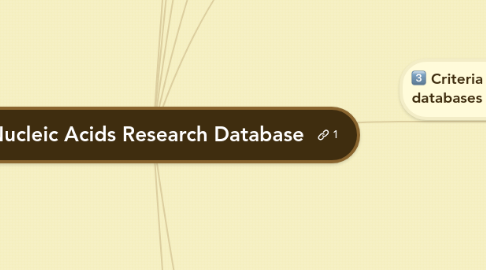
1. Why we need to group these databases?
1.1. To provide a higher-order organization of large-scale data submitted by a single organization or a consortium, or relating to the same whole-genome assembly.
1.2. To track tools, databases, and methods in the field
1.3. So that information of the resources can be most effectively exploited
1.4. More systematic and manageable
1.5. Keyword tagging allows users to narrow down the resources that suit their needs
2. Why databases are created and shared?
2.1. To provide better integration and cross-referencing tools
2.2. Latest development can be kept up-to-date
2.3. To allow interaction between researchers
2.3.1. Everyone has the opportunity to help make the collection better and more meaningful
2.4. To store the massive information of research work
2.5. Allow multiple users to have access to data
3. Why some databases are no longer in the databases and dropped from it?
3.1. Deleted as they are found to be obsolete and non-responsive.
3.2. Commercialized and does not provide free version anymore
3.2.1. e.g: ExDom database of exon–intron structures of genes in seven eukaryotic genomes
3.3. Improved annotation of the human genome made some resources that covered specific areas of the genome no longer useful
3.4. Some are integrated into larger projects
3.4.1. e.g: segmental duplication database were merged with Database of Genomic Variants
3.4.2. e.g: NCBI’s Cancer Chromosomes database were merged into dbVar
4. Prepared by Group 4:
4.1. CHEW YEE LING
4.2. CHONG WAI LUN
4.3. TAN KAR MING
4.4. TAN WEE TIEN
5. Numbers available :
5.1. 1512 online databases sorted into 14 categories and 41 subcategories
5.1.1. 88 new online databases
5.1.2. 77 update articles on databases that have been previously featured in the NAR
6. Criteria for selection into NAR databases
6.1. Free accessible
6.2. Consistent
6.3. Credible and Trustable
6.4. Significance and scientific excellence.
6.5. Originality
6.6. Novel development
6.7. Focus on various aspects of nucleic acids and proteins involved in nucleic acid metabolism interactions
7. Organisation of databases and its major grouping: (Categories list)
7.1. Nucleotide Sequence Databases
7.1.1. International Nucleotide Sequence Database Collaboration
7.1.1.1. DDBJ - DNA Data Bank of Japan
7.1.1.2. European Nucleotide Archive
7.1.1.3. GenBank
7.1.2. Coding and non-coding DNA
7.1.2.1. Dfam
7.1.2.2. SINEBase
7.1.2.3. UCNEbase
7.1.2.4. DoriC
7.1.3. Gene structure, introns and exons, splice sites
7.1.3.1. APPRIS
7.1.3.2. ChiTaRS
7.1.3.3. GeneTack
7.1.3.4. HEXEvent
7.1.3.5. SpliceAid-F
7.1.3.6. Spliceosome Database
7.1.4. Transcriptional regulator sites and transcription factors
7.1.4.1. ChIPBase
7.1.4.2. Factorbook
7.1.4.3. HOCOMOCO
7.1.4.4. TFClass
7.2. RNA sequence databases
7.2.1. BSRD
7.2.2. DIANA-LncBase
7.2.3. Lncipedia
7.2.4. PlantRNA
7.2.5. SomamiR
7.2.6. YM500
7.2.7. DARNED
7.3. Protein sequence databases
7.3.1. General sequence databases
7.3.1.1. UniProt
7.3.2. Protein properties
7.3.2.1. eProS
7.3.2.2. SwissSidechain
7.3.2.3. TOPPR
7.3.3. Protein localization and targeting
7.3.3.1. ValidNESs
7.3.4. Protein sequence motifs and active sites
7.3.5. Protein domain databases; protein classification
7.3.5.1. OrtholugeDB
7.3.6. Databases of individual protein families
7.3.6.1. Cyanolyase
7.3.6.2. DoBISCUIT
7.3.6.3. EENdb
7.3.6.4. KIDFamMap
7.3.6.5. UUCD
7.4. Structural Database
7.4.1. Small molecules
7.4.2. Carbohydrates
7.4.2.1. Glycan Fragment DB
7.4.3. Nucleic acid structure
7.4.3.1. MetalPDB
7.4.3.2. Voronoia4RNA
7.4.4. Protein structure
7.4.4.1. D2P2
7.4.4.2. Genome3D
7.4.4.3. SIFTS
7.4.4.4. 2P2Idb
7.4.4.5. NPIDB
7.4.4.6. PDBe
7.4.4.7. CATH
7.4.4.8. SCOP
7.5. Genomics Databases (non-vertebrate)
7.5.1. Genome annotation terms, ontologies and nomenclature
7.5.1.1. dcGO
7.5.1.2. DGA
7.5.1.3. BioGPS
7.5.2. Taxonomy and identification
7.5.3. General genomics databases
7.5.4. Viral genome databases
7.5.4.1. HBVdb
7.5.4.2. Papillomavirus Episteme
7.5.5. Prokaryotic genome databases
7.5.5.1. meta.MicrobesOnline
7.5.5.2. SecReT4
7.5.5.3. SEVA
7.5.5.4. MicroScope
7.5.5.5. EcoCyc
7.5.5.6. EcoGene
7.5.5.7. RegulonDB
7.5.6. Unicellular eukaryotes genome databases
7.5.6.1. PR2
7.5.7. Fungal genome databases
7.5.7.1. NetwoRx
7.5.8. Invertebrate genome databases
7.5.8.1. MonarchBase
7.5.8.2. WDDD
7.5.8.3. WormQTL
7.5.8.4. FlyAtlas
7.6. Metabolic and Signaling Pathways
7.6.1. Enzymes and enzyme nomenclature
7.6.1.1. EBI Enzyme Portal
7.6.2. Metabolic pathways
7.6.2.1. ClusterMine360
7.6.2.2. ECMDB
7.6.2.3. LAMP
7.6.2.4. MetaboLights
7.6.2.5. RNApathwaysDB
7.6.2.6. WholeCellKB
7.6.3. Protein-protein interactions
7.6.3.1. prePPI
7.6.3.2. PTMcode
7.6.3.3. SynSysNet
7.6.3.4. TissueNet
7.6.4. Signalling pathways
7.6.4.1. Quorumpeps
7.7. Human and other Vertebrate Genomes
7.7.1. Model organisms, comparative genomics
7.7.1.1. H2DB
7.7.1.2. NHPRTR
7.7.1.3. OikoBase
7.7.1.4. RhesusBase
7.7.1.5. ZInC
7.7.1.6. GenColors
7.7.1.7. Genomicus
7.7.2. Human genome databases, maps and viewers
7.7.3. Human ORFs
7.8. Human Genes and Diseases
7.8.1. General human genetics databases
7.8.1.1. NIH Genetic Testing Registry
7.8.2. General polymorphism databases
7.8.2.1. dbVar
7.8.2.2. DGVa
7.8.2.3. ClinVar
7.8.3. Cancer gene databases
7.8.3.1. CellLineNavigator
7.8.3.2. TSGene
7.8.4. Gene-, system- or disease-specific databases
7.8.4.1. LncRNADisease
7.9. Microarray Data and other Gene Expression Databases
7.9.1. CircaDB
7.9.2. HemaExplorer
7.9.3. METscout
7.9.4. Allen Brain Atlas
7.9.5. ArrayExpress
7.9.6. Gene Expression Omnibus
7.9.7. GPX
7.9.8. Stanford Microarray Database
7.10. Proteomics databases
7.10.1. Protein and peptide identifications and their associated supporting evidence
7.10.2. Details of post-translational modifications
7.10.3. e.g. MitoMiner
7.11. Other Molecular Biology databases
7.11.1. Drugs and drug design
7.11.1.1. BioLiP
7.11.1.2. G4LDB
7.11.1.3. GDSC
7.11.1.4. NPACT
7.11.1.5. StreptomeDB
7.11.1.6. SwissBioisostere
7.11.2. TCMID
7.12. Organelle databases
7.13. Plant databases
7.13.1. General plant databases
7.13.1.1. PGDD
7.13.1.2. PIECE
7.13.2. Arabidopsis thaliana
7.13.3. Rice
7.13.3.1. OrysPSSP
7.13.3.2. RiceFREND
7.13.4. Other plants
7.14. Immunological databases
7.14.1. InnateDB
7.15. Cell biology
7.15.1. CloneDB
7.15.2. LUCApedia
7.15.3. NCBI Bookshelf
8. Evolution of NAR database
8.1. Start April of 1991 (18 articles) & May of 1992 (19 artiles)
8.1.1. Nuleotide sequence database
8.1.1.1. GenBank
8.1.1.2. the EMBL Data Library
8.1.1.3. compilations of small RNA, tRNA, and 5S, 16S, and 23S rRNA sequences
8.1.1.4. DNA sequences from Escherichia coli and a human genome database (GDB)
8.1.2. Protein database
8.1.2.1. SWISS-PROT
8.1.2.2. PIR,
8.1.2.3. PROSITE
8.1.2.4. Restriction Enzyme Database (REBASE)
8.1.2.5. Transcription Factors Database (TFD)
8.1.2.6. Histone database
8.1.3. medical genetics database
8.1.3.1. Haemophilia B
8.2. July 1, 1993- First formal Database Issue (24 articles)
8.2.1. RNA and protein structure
8.2.2. ENZYME database
